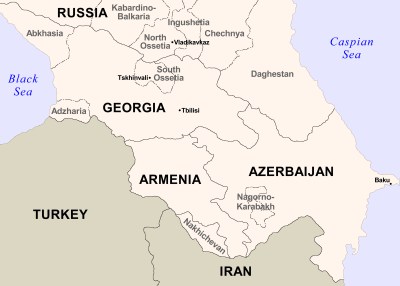 |
 |
| South Ossetia |
 |
|
|
In the very heart of the Georgia is situated Tskhinvali / South Ossetia. At an altitude of 1000 meters and more above the sea level is to be found 89.3 % of the territory of South Ossetia. The mountain landscape also determined largely South Ossetia's climate. It is shielded against the cold northern winds by the Main Caucasus Range, which results in the fact that even at great heights it is warmer here than in the Northern Caucasus. Administratively it is divided into four regions: the Tskhinval, Dzhava, Leningori and Znaur. The industrial, cultural, and administrative centre of the Republic of South Ossetia is it's capital, the city of Tskhinval. In South Ossetia reside Russians, Georgians, Armenians, Greeks, - a total of 40 nationalities. |
|
 |
 |
|
On 20 April 1922, after the Sovietization of Georgia in 1921, the South Ossetian Autonomous Oblast (AO) was formed. Georgian writers have claimed that, like the Abkhazian ASSR, the South Ossetian AO had been formed by the Bolsheviks to create permanent sources of tension, so as to enable the Kremlin to control Georgia more easily. Both Abkhazia and South Ossetia were said to be run on an ethnocratic basis, to the detriment of Georgian national interests. Hence the perceived Georgian need to curtail if not abolish these autonomous entities. The response from the South Ossetes was either to try to secure federal status within Georgia or, failing that, to seek to be reunited with North Ossetia, forming part of Russia. |
|
| Conflict between bordering countries has been constant. December 1990 the Georgian Parliament made a move to abolish South Ossetian autonomy which resulted in violent clashes giving Russia further legitimation for intervening in Georgian affairs and ultimately contributing to South Ossetia's de facto separation from Georgia), but it should also be seen as an ill-considered retaliation for the declaration by the "South Ossetian Democratic Republic" of its separation from Georgia, which had been made several days before. What ensued was a territorial war in which both sides were defending "their land" and which the absence of regular armies made even more brutal. | |
| Moderate tendencies within the Ossetian movement had understood very well that secession from Georgia was a reckless move. Compromises with the Georgian government would have been possible, insofar as public opinion in Georgia had never opposed granting quite extensive cultural rights to the minorities. Only some groups within the Georgian independence movement attempted to co-operate with these moderate tendencies within the national minorities. Unfortunately, such attempts were rare and inconsistent. | |
 |
 |
| In 2005 Central Bank of the Republic of South Ossetia issued a 10 Roubles Coin. Obverse depict: Colorized Enamelled Coat of Arms of South Ossetia. Reverse depict: The face value of 10 Roubles. Apparently this is the first coin minted by this unrecognised state and is 75% silver crown with mintage to 250 pieces. | |
| Micro-Nations | |
| Chiefa Coins | |